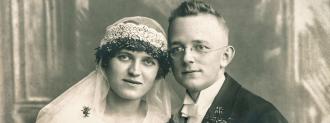When you pose for a photograph, you probably tilt your head this way or that between shots so that the camera can capture your different angles.
Now, the genealogy site MyHeritage has created a deepfake tool that can predict those moments from a still photograph — and it’s bringing to life the faces of people’s long-dead relatives.
Old Photos, New Life
Thanks to the ubiquity of smartphones, most people now have a camera in their back pockets — and we love to use those cameras to take photos of ourselves.
One 2015 study estimated that the average Millennial will take 25,000 selfies over the course of their lifetime; assuming they keep at it, they will spend a total of 38 hours every year staring into their own cameras.
Add in the photos of us that other people take — plus all the videos we record — and our descendants should have little trouble piecing together what we looked like while we were alive.
That’s not the case for older generations.
For more than a century after the advent of portrait photography, the high cost and complexity of the process meant it was reserved for special occasions — some people might go their whole lives having posed for just a single photo.
Today, those rare photos are often the only evidence we have of what our ancestors looked like — and now, MyHeritage’s deepfake tool is pouring new life into them.
New Deepfake Tool
MyHeritage calls its deepfake tool Deep Nostalgia.
To use it, a person signs up for a free MyHeritage account and uploads a photograph of a person.
Deep Nostalgia then enhances the image before generating a short gif of the subject’s face moving the same way it might have as they posed for the shot — blinking, smiling, or lifting their chin this way or that.
The technology behind the deepfake tool was developed by Israel-based startup D-ID, and it’s built around what the company calls “driver videos” — pre-recorded videos of face models looking around like they might while having their photo taken.
When a person uploads a photo to Deep Nostalgia, the tool maps the face of the person in the photograph and then chooses a match for it among the driver videos. It then animates the face in the still photograph, causing it to move the same way as the face in the driver video.
Users only get five freebies with Deep Nostalgia — after that, they have to pay — and the deepfake tool can only animate one face at a time.
Deep Nostalgia Goes Viral
In the first 48 hours after MyHeritage announced Deep Nostalgia, it racked up more than one million uploads, and at the time of writing, the site appeared to be overwhelmed with visitors.
Many users have already taken to social media to share animations of their loved ones and their feelings about the technology.
“This actually moved me to tears,” Twitter user @chiddickstree wrote. “I have never seen a moving image of Dad, he sadly died when I was 3, incredible and emotional thank you @MyHeritage.”
Instead of uploading photos of their relatives, others have used the deepfake tool to animate the faces of, well, pretty much everyone: historical figures, memes, video game characters, etc.
Not every photo lends itself to the technology, and in some cases, the animations are downright creepy. Still, the tool is a remarkable and accessible way for modern generations to envision the lives of those that preceded them.
“Seeing our beloved ancestors’ faces come to life in a video simulation lets us imagine how they might have been in reality, and provides a profound new way of connecting to our family history,” MyHeritage CEO Gilad Japhet said in a press release.
We’d love to hear from you! If you have a comment about this article or if you have a tip for a future Freethink story, please email us at [email protected].






